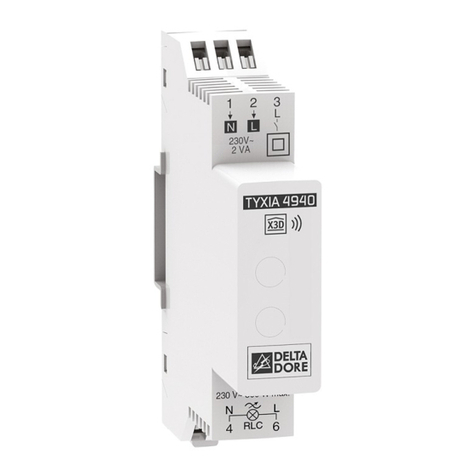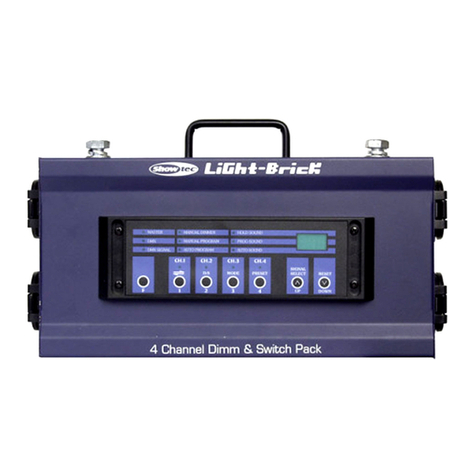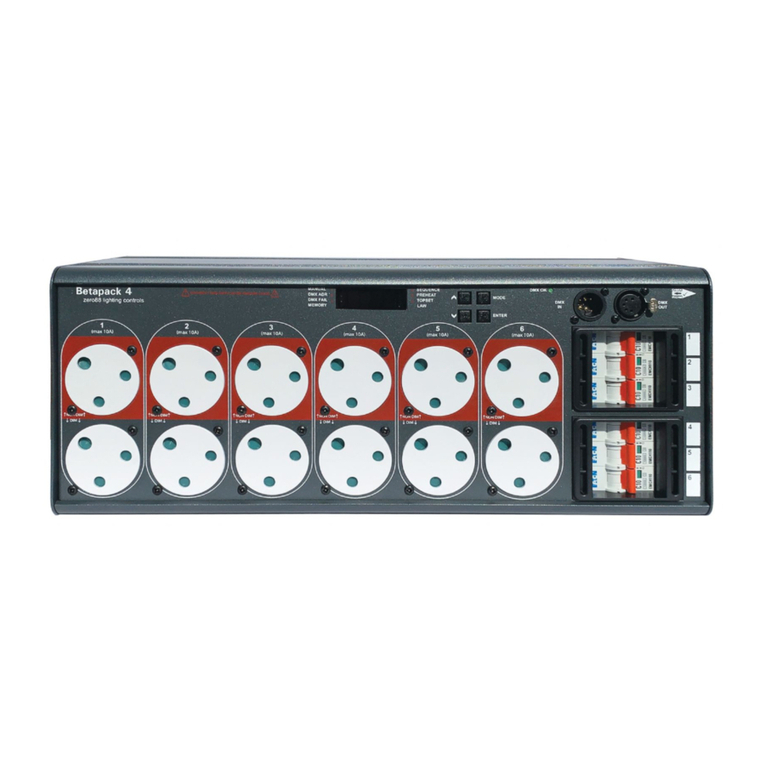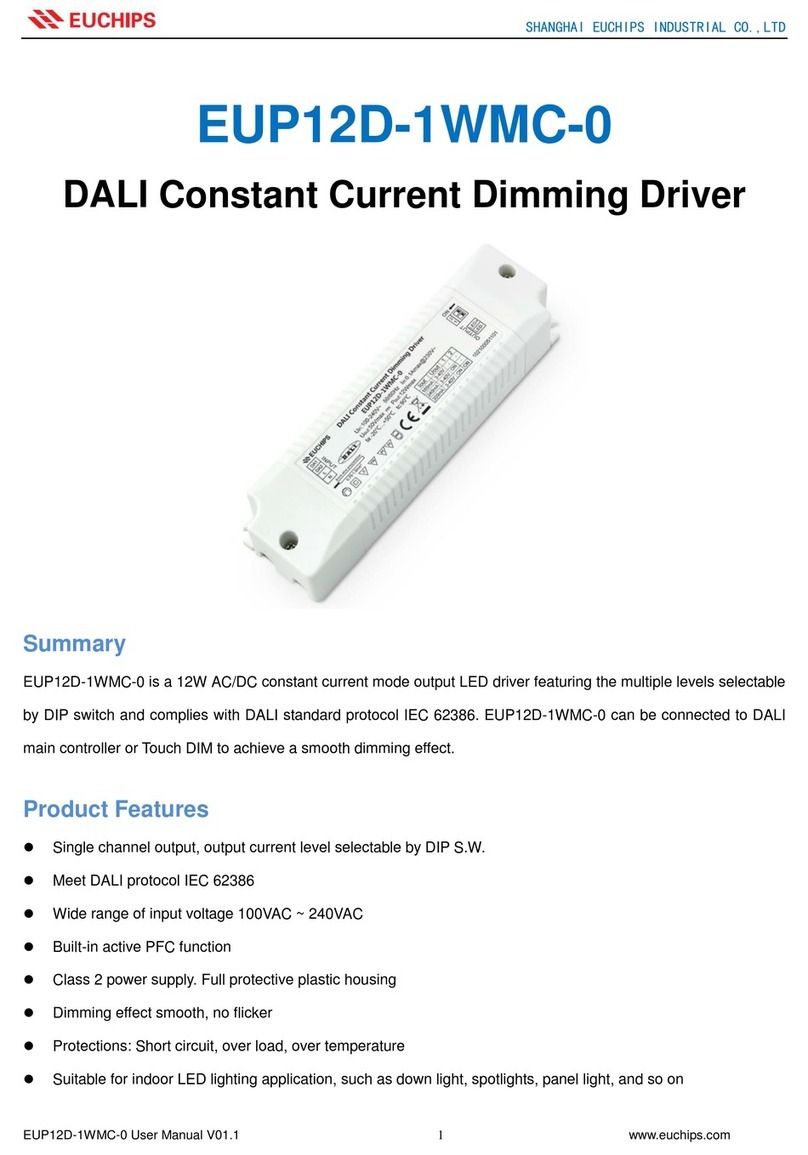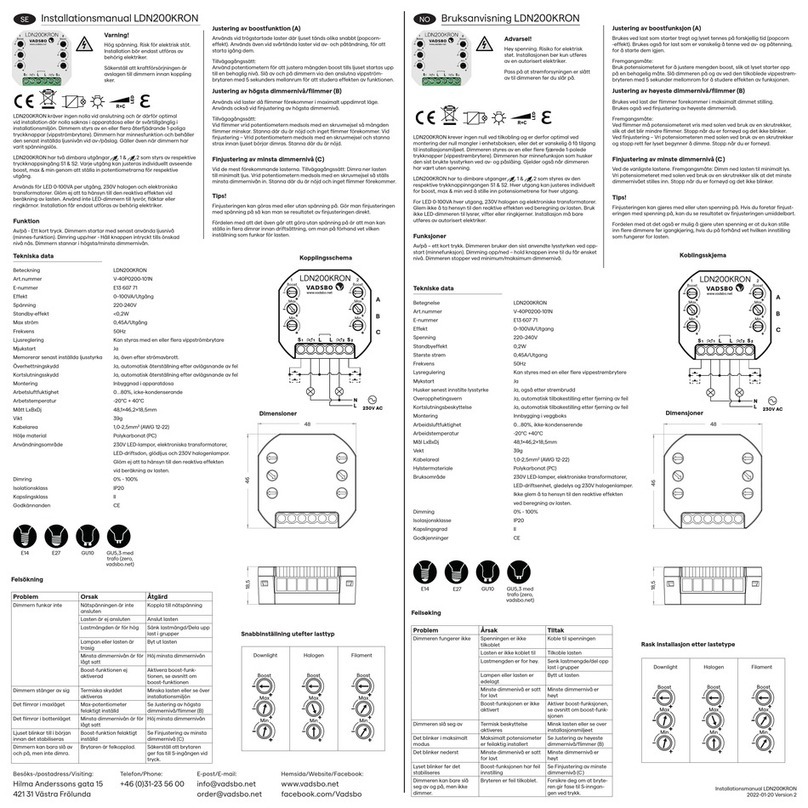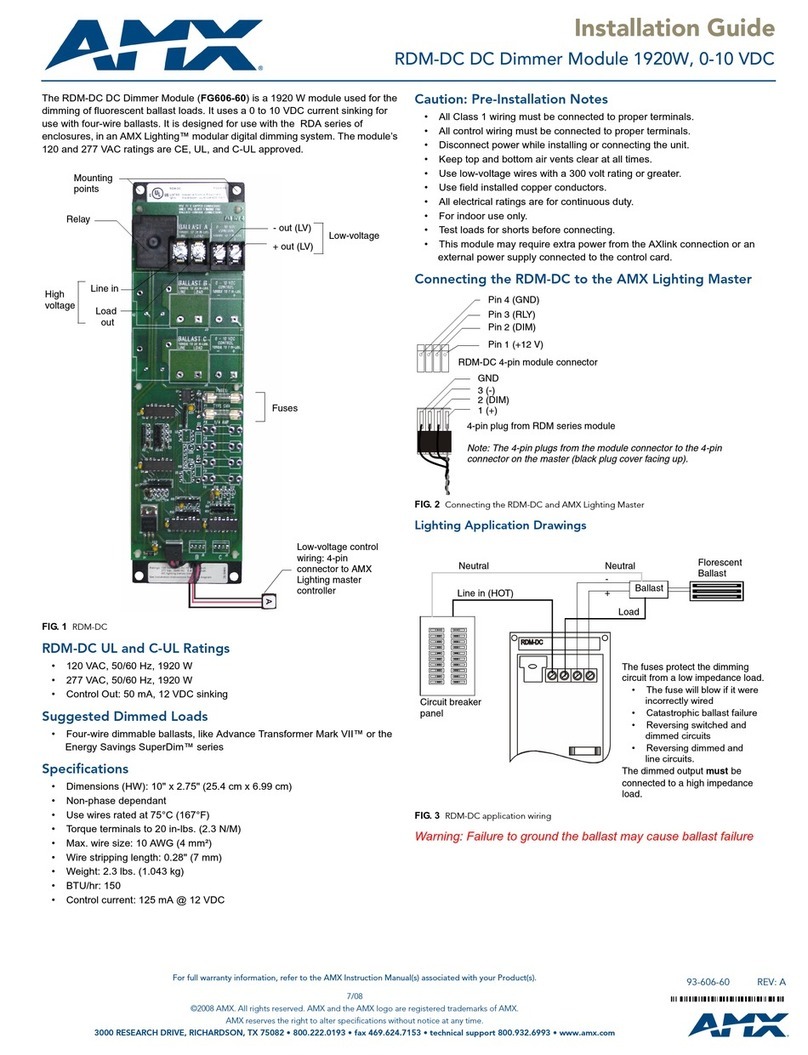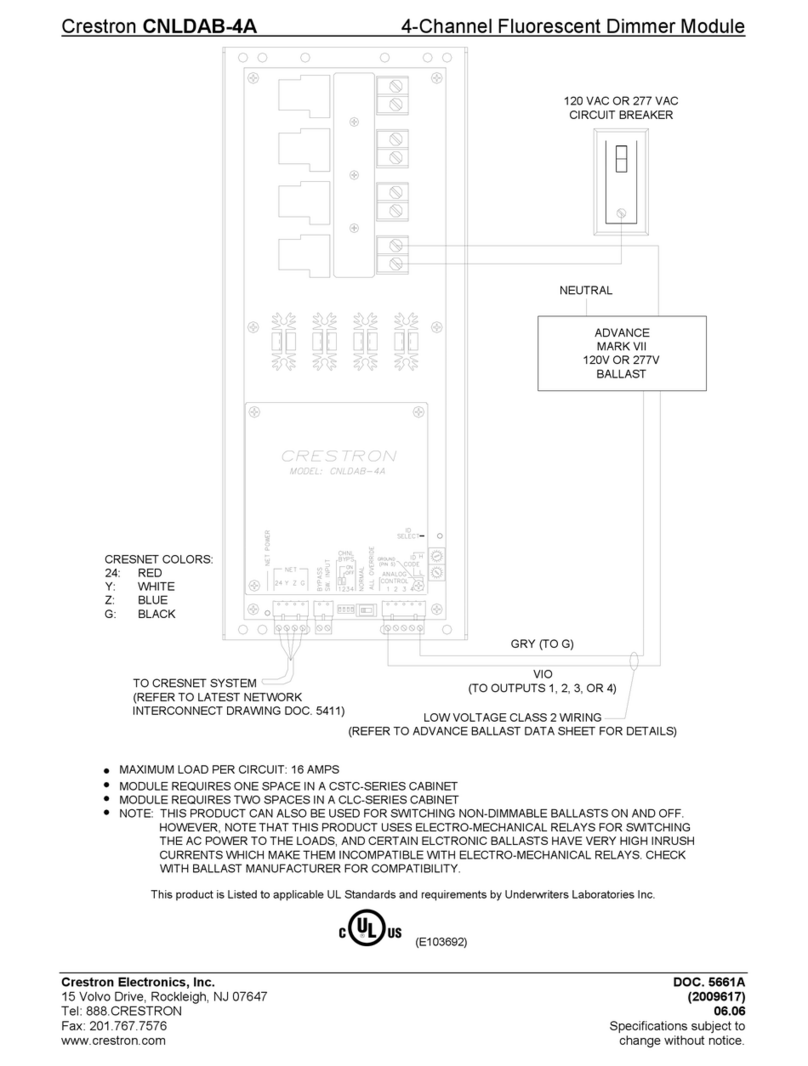IES PR-6 User manual

IES PR-6 dimmer pack Operators’ Manual v. 1.1 25-04-2002 1
Operator Manual
PR-6 rack mounted
dimmer pack
on
dmx
DMXINSTCHAS
PWR MANCONF
INFOCHKEXIT
ENT
L D:001*
CH 1 2 3 4 5 6 A:016*
Contents:
1 Introduction.........................................................2
1.1 Product range............................................2
1.2 Main features of PR-6...............................2
2 Unpacking and installation.................................2
2.1 Unpacking & checking..............................2
2.2 Positioning.................................................2
2.3 Connections ..............................................2
2.4 Safety......................................................... 2
3 Control panel layout...........................................3
4 Function overview..............................................4
4.1 Maximum and minimum levels................. 4
4.2 Response speed.......................................4
4.3 Non-dim operation ....................................4
4.4 Local control..............................................4
4.5 Dimmer curves..........................................4
4.6 Status reporting.........................................4
4.7 Backup settings.........................................4
5. Information displays and manual control.........4
5.1 To check dimmer performance ................4
5.2 To check software versions......................4
5.3 To manually control a dimmer level.........5
5.4 To operate the chaser...............................5
6 Programming......................................................5
6.1 Flow diagram.............................................5
6.2 General Programming Advice..................5
6.3 Front Panel Controls.................................6
6.4 General controls .......................................6
6.5 DMX programming....................................6
6.6 Serial address...........................................7
6.7 Maximum & Minimum levels.....................8
6.8 Response time.......................................... 8
6.9 Dimmer curves..........................................9
6.10 Non-Dim operation.................................. 9
6.11 Start Mode...............................................9
6.12 Passwords ............................................10
6.13 Sleep mode...........................................11
6.14 Fault reporting.......................................11
6.15 Return to factory settings......................11
7. DimSTAT.........................................................12
8. Fault finding.....................................................12
8.1 Reported faults........................................12
8.2 First line maintenance.............................12
9. Specifications..................................................13
10. Declaration of conformity..............................14
11. Flow chart......................................................15
12. Index..............................................................16

IES PR-6 dimmer pack Operators’ Manual v. 1.1 25-04-2002 2
1 Introduction
1.1 Product range
This handbook describes the operation and
programming for the IES PR-6 6 x 2.5kW rack
mounting dimmer pack. The dimmers covered by
this handbook are:
9908 PR-6, 2 x 2.5kW, 24A three
phase input, 6 x CEE17 16A, 6 x
dual Schuko outputs or 6 x dual
French outputs
9913 PR-6, 2 x 2.5kW, star/delta
RCBO input, 6 x CEE17 16A, 6 x
dual Schuko outputs or 6 x dual
French outputs
1.2 Main features of the PR-6
The PR-6 is a fully digital triac dimmer pack with
MCB overcurrent protection per circuit, a three
phase 4-pole 30mA RCD or a star/delta input with
RCBO and a choice of socket outlets included in the
design. The programming facility is one of the most
sophisticated available, and the control panel
includes a backlit menu-driven LCD screen to set
and review operational parameters, performance
and status information. The PR-6 shares many of
the advanced features of the ‘itec’ range of IGBT
dimmers from IES, including DimSTAT, the bi-
directional network used for status and circuit fault
analysis, remote programming and software
updates.
2 Unpacking and installation
2.1 Unpacking & checking
The PR-6 dimmer pack is a self-contained dimming
system and only requires a suitable mains input
connector.
The PR-6 dimmer pack is packed to withstand
normal transportation, but before operating the unit,
check there is no sign of transit damage which could
affect the operation and safety of the dimmer.
2.2 Positioning
The PR-6 dimmer pack is an extremely versatile
dimmer, and can be incorporated in a 19” equipment
rack, or used as a portable dimmer. It is designed for
forced ventilation cooling and care must be taken to
ensure adequate ventilation especially when the PR-
6 is built into a cabinet. The PR-6 is supplied with
mountings suitable for 19” equipment enclosures,
and accommodates 3U of panel space.
2.3 Connections
Note: All electrical connections to the PR-6
dimmer pack must be made by a suitably-
qualified person.
2.3.1 Power input connections
Input power is supplied via a 3-phase, neutral and
earth 4mm2flexible cable or a 4-wire delta supply
cable. For ease of installation and removal, a
suitable plug and socket, such as a 32A three phase
CEE17, is recommended.
2.3.2 Power output connections
The PR-6 has a choice of one CEE17 16A, or twin
Schuko or twin French sockets per channel.
Connections to the loads are simply made by fitting
the appropriate plug to the load cable.
2.3.3 DMX data signal connections
The dimmers are controlled using DMX 512. This is
connected by a two-pair and shield high-speed data
cable with XLR 5-pin connectors (male = input;
female = output).
Pin connections are:
10V shield
2DMX +
3DMX -
4DimSTAT –(optional)
5DimSTAT + (optional)
The DMX network supports up to 32 PR-6 dimmer
packs (192 dimmers in total) connected to each
DMX line. For larger installations where more DMX
lines are required, the use of a DMX booster/isolator
is recommended. Any booster/isolator used has to
accommodate bi-directional data on pins 4 and 5 for
DimSTAT to operate. Suitable boosters are IES
code 9601 (5 channels) or 9815 (10 channels).
Termination is required for both DMX and DimSTAT
data on all networks. The last DMX output socket in
the line has to be terminated with two 120 1/4 Watt
resistors connected between pins 2 and 3 (DMX)
and between 4 and 5 (DimSTAT). A ‘dummy plug’
XLR male connector with the termination resistors
fitted is recommended for this purpose.
Note: If DimSTAT communications network is
not required, the DMX cable specification
may be reduced to a single pair.
2.4 Safety
Even though the PR-6 dimmer pack is equipped with
MCBs per channel and a RCD or RCBO input
protection device, all normal electrical safety
procedures must be applied. Do not use the dimmer
if the mains input cable has been damaged, or the
body of the case is not intact.

IES PR-6 dimmer pack Operators’ Manual v. 1.1 25-04-2002 3
3 Control panel layout
on
dmx
DMX
INST
CHAS
PWR MANCONF
INFO
CHKEXIT
ENT
L D:001*
CH 1 2 3 4 5 6 A:016*
ON LED
Illuminates red when power is applied, and the
mains RCD is switched on.
DMX LED
Illuminates red continuously when valid DMX is
present. LED flashes when there is no DMX signal.
ENT & cursor arrows
ENT (ENTer) completes a programming step and
records the information in the memory
The four cursor arrows provide navigation through
the set-up menu, and the means to enter data.
éUp cursor. Higher level menu feature
or move cursor up in display screen or
number increment.
êDown cursor. Lower level menu
feature or move cursor down in display
screen or number decrement
çLeft cursor. Move cursor left in display
screen
èRight cursor. Move cursor right in
display screen
DMX
Selects DMX address per channel when the single
mode is selected, or the first address of the group of
six when the joined mode is selected.
INST
INSTall function. To set-up dimmer functionality
during installation with options as follows:
•DimSTAT communication address
•DMX failure options
•DMX backup levels
•DMX configuration (individual or combined)
•Channel configuration (individual or combined)
•Sleep mode
•Minimum level reset (preheat off when DMX is
not present)
•Factory reset
•Channel information
•Password set-up
•Dimmer hardware configuration
CHAS (with LED)
CHASe. Provides set-up for the dimmer’s internal
chase system for stand-alone display effects. The
LED illuminates when the dimmer is in the ‘chase
mode.
CONF
CONFigure. Access to a sub-menu to set the
detailed configuration for individual or combined
dimmer channels. Options available are:
MAX MAXimum. Sets the
maximum output level from
30% to 100%, individually or
combined.
MIN MINimum. Sets the minimum
output level from 0% to
29.9%, individually or
combined.
T-IN Response time to fade in from
0.00 secs to 99.9 secs.
T-OUT Response time to fade out
from 0.00 secs to 99.9 secs.
CURVE Dimmer law selection
I/O Non-dim On/off operation
PRIORITY Not available.
PHASE Not available.
MODE Start mode (normal, soft start,
burst, proportional)
MAN
MANual. Provides manual control of each channel
for circuit testing and pre-setting.
EXIT
Returns to the opening screen menu option without
recording changes.
INFO
INFOrmation. Provides a display of the nominal
supply voltage and installed software version.
CHK (with LED)
ChecK. Displays a log of any circuit or dimmer
faults. LED illuminates if an error occurs.
PWR
Not available on this range.

IES PR-6 dimmer pack Operators’ Manual v. 1.1 25-04-2002 4
4 Function overview
4.1 Maximum and minimum levels
The maximum output of the dimmer may be
adjusted to improve lamp life or to limit the power
used. A minimum level (preheat) may be necessary
with some filaments to improve the speed of fast
flashes or chases. A 'Minimum level reset' option
exists (INST>General settings menu) to switch off
the preheat when the DMX signal is not present (i.e.
when the control desk is switched off).
4.2 Response speed
The time taken for a dimmer to ‘fade’ to the applied
control signal level is used to control the rate of
change of current to the filament improve lamp life
for higher wattage filaments.
4.3 Non-dim operation
Each dimmer may be selected to operate as a
dimmer, or as a non-dim switch.
4.4 Local control
PR-6 dimmer packs have a range of integrated
control facilities for basic operation without a control
desk. These include live manual control of each
dimmer level, preset recorded levels for fixed display
lighting, and an integral chaser with 20 pre-set
chase patterns and variable speed and level.
4.5 Dimmer curves
A selection of dimmer curve transfer functions (the
relationship between from control signal level and
dimmer output) are available to compensate for the
different visual responses of a live audience or a TV
camera, and to provide improved dimming for non-
resistive loads such as fluorescent tubes.
4.6 Status reporting
All IES dimmers incorporate a bi-directional
communications system called DimSTAT which
provides feedback of the dimmer status and fault
reporting to a PC. DimSTAT also enables a remote
PC to control any dimmer in the network, and to
update the dimmer’s internal operating software and
preset options. DimSTAT network software and a
remote PC are optional extras
4.7 Backup settings
Should the DMX signal fail, the PR-6 dimmer pack
can be programmed to hold the present level, fade
to zero or fade to a pre-programmed backup level.
5. Information displays and
manual control
The following group of buttons provides direct
access to detailed set-up and status information and
manual override controls, and do not require
passwords for access.
5.1 To check dimmer performance
1. Press INST.
2. Press éor êto choose CHANNEL INFO
menu. Press ENT.
3. The screen shows:
INFO CH:[1]
CURRENT 04,7A
4. Press çor èto select other information
as follows:
CURRENT: current in Amps measured at the
output
VOLTAGE: voltage at the input of the dimmer
TEMPERATURE: internal temperature
DMX: DMX level received
ACTUAL: the level the dimmer is responding
to (may differ from DMX value due to MIN,
MAX or MAN influence).
STATUS: error message(s) with details.
5. Press éor êto select another dimmer
channel (shown in square brackets), or,
6. Press EXIT to leave the screen.
5.2 To check dimmer software versions
1. Press INFO, and the screen shows:
P1:0105 P2: ____
P3:____ SYS:X.43
Where: P1, P2 and P3 are the dimmer
processor software versions and SYS is
the front panel processor software.
2. After 3 seconds, the screen automatically
resets to show the normal output details.

IES PR-6 dimmer pack Operators’ Manual v. 1.1 25-04-2002 5
5.3 To manually control a dimmer level
It is possible to control any dimmer directly from the
front panel using the cursor controls to set the
desired level. This can be used for testing circuits,
overriding control signals or setting an independent
fixed level. The level is mixed with any other
incoming signal on a highest level takes precedence
basis.
1. Press MAN, and its associated red LED
lights.
2. The screen shows:
L: ;;33;
CH:T123456
3. Use çor èto select a channel number
(active channel number is underlined), or
‘T’ which controls all channels together.
4. Press éor êto adjust the level. The
dimmer output is live while the level is
being adjusted.
5. Press ENT to leave the menu and record
the changes or EXIT to leave the previous
settings unchanged.
5.4 To operate the chaser
The PR-6 dimmer pack has a sequence chaser to
provide basic effects without a control desk. This is
primarily used for exhibition and display lighting
purposes. See section 6.? For programming the
chaser.
1. Press CHAS.
2. The screen displays shows:
CH ST SP L FADE
01 00 1,0 3OFF
where:
CH is chase number
ST is step number
SP is speed (in seconds) from one step to
another
L is a bargraph showing the master intensity
FADE selects either a fading chase (ON) and
a switching chase (OFF)
3. Press çor èto move the underline
beneath the CH number, and use éand
êto select the chase number required.
4. Move the underline to SP to adjust the
chase rate, underline L to set a new
master intensity level, and choose to a
fade [ON] or switching effect [OFF] by
underlining FADE.
5. Press ENT to start the chase, and the
screen shows e.g.:
CH 3_3_3_AUTO
05 01 1,0 3OFF
6. The step number will increment as the
chase progresses, restarting at 1 at the
end of each cycle.
7. With the chase number underlined, press
éor êto switch to another chase pattern.
6 Programming
6.1 Flow diagram
An overview of the flow chart showing the menu
structure and options is shown in section 11.
6.2 General Programming Advice
6.2.1 Passwords
For clarity, the following sections which describe
programming activities do not refer to the entry of
passwords. Passwords are included to prevent
unauthorised access to the DMX, CONFigure and
INSTall menu trees. The passwords are 4-digit
numbers with a factory default of 0000 (no password
necessary). It is possible to have the same
password for all, or separate passwords for each
menu tree. If any of the protected menus is selected,
the subsequent screen requests a password. This is
achieved by pressing the relevant çand ècursor
buttons to select the digit, and the éand êcursor
buttons to enter the number.
6.2.2 Navigation through the menus
The cursor buttons are used to move around the
menu screens, and to activate a set-up option or
parameter prior to adjustment. When a parameter or
option is activated, it is shown in square brackets,
e.g. [240] and it is this item which you are changing
on the screen. When you press ENT to confirm the
change, the screen will show:
DATA IS STORED
IN MEMORY
As this happens for each menu option, it is not
included in each following instruction.
6.2.3 Channel characteristics
All dimmer-specific functional parameters may be
set on a dimmer-per-dimmer basis. Thus each
dimmer may have a different response time, curve,
maximum level etc. if required. Alternatively, all
dimmers in one PR-6 dimmer pack can be

IES PR-6 dimmer pack Operators’ Manual v. 1.1 25-04-2002 6
programmed together, depending on whether the
dimmer set-up has been set to ‘SINGLE or ‘JOINED’
(see paragraph 6.4.1). If the configuration is set to
single, a number is shown in each relevant channel
reference [4], and if all dimmers are programmed
together, a T is shown in square brackets [T]. Note
that if T is activated, an underscore bar is added,
making it appear as an ‘I’.
6.3 Front Panel Controls
All of the performance and control characteristics,
measurements and status reports, are available
from the front panel controls and LCD screen. When
power is applied and the RCD is switched on, the
power LED will illuminate. The DMX LED will
illuminate if a valid DMX signal is present.
During the power-up reset process, the LCD display
shows identification details and the software version
before displaying the output screen:
L: 3;33;_D:001?
CH:123456 A:032v
This display shows the channel levels (bargraphs at
the top left), the DMX address of the first channel in
the PR-6 dimmer pack (D:xxx) and the DimSTAT
address of the unit (A:xxx). The number of
bargraphs shown relates to the number of dimmers
in the PR-6 dimmer pack –either 2, 4 or 6.
Note: A questionmark (?) adjacent to the DMX
address shows the DMX signal is not
valid, and the ‘v’ adjacent to the DimSTAT
address number indicates communication
is active.
6.4 General controls
PR-6 dimmer packs have the capacity to store
performance characteristics individually for each
dimmer or combined for all dimmers in the group.
This feature is independent of the choice of DMX
numbering scheme, thus the dimmers may have
individual characteristics, but with consecutive DMX
addresses.
6.4.1 To change the dimmer characteristic set-up
scheme:
1. Press INST.
2. Press êor éto choose GENERAL
SETTINGS menu.
Press ENT.
3. Press êor éto choose CONFIG
CHANNEL menu.
Press ENT.
4. The screen shows:
GENERAL
CH_CONF. [SINGLE]
5. Use éor êto select either SINGLE (for
different individual channel parameters) or
JOINED (if all dimmers have the same
characteristics).
6. Press ENT (to record the changes) or
EXIT (to leave the previous settings
unchanged, and return to the home page).
6.5 DMX programming
Each dimmer in the PR-6 dimmer pack is assigned a
DMX channel number. A feature is provided to set
sequential number groups (‘joined’ addressing)
instead of individual settings (‘single’ addressing).
When programming a dimmer, IT IS IMPORTANT
TO SET THE DMX ADDRESSING SCHEME
BEFORE the individual characteristics are set, as a
later change can reset previously recorded individual
channel characteristic settings.
6.5.1 To set up DMX addressing scheme:
1. Press INST.
2. Press êor éto choose GENERAL
SETTINGS menu.
Press ENT.
3. Press êor éto choose DMX ADDRESS
menu.
Press ENT.
4. The screen shows:
GENERAL
DMX MODE [SINGLE]
5. Use éor êto select either SINGLE (for
different individual DMX addresses) or
JOINED (if the dimmers are numbered
sequentially from the start address).
6. Press ENT (to record the changes) or
EXIT (to leave the previous settings
unchanged, and return to the home page).
6.5.2 To set-up DMX addresses:
1. First set the DMX scheme as described
above (either individual or start address).
2. Press DMX, and the screen displays:
DMX: [001] 002
CHAN.: 1 2
3. If SINGLE has been selected, two
channels are displayed at a time, with their
relevant DMX address. Use éand êto
select the address needed for the first
dimmer channel and move to other
channels by pressing çand èand
continue adjusting each DMX address by
pressing éand êas before.
4. If JOINED has been selected, only one
DMX number line is entered which is the

IES PR-6 dimmer pack Operators’ Manual v. 1.1 25-04-2002 7
address for dimmer 1. The remaining
dimmers are automatically addressed in
sequential order. Press ENT to store the
settings and to return to the previous
menu.
Note: DMX address 000 deselects the channel
from operation. Valid DMX numbers are
between 001 -512. If higher dimmer
numbers are used by the control desk, the
number has to be rationalised to a base of
512 for the dimmer address (e.g. channel
600 is (600 -512) = DMX address 8.
6.5.3 To set up a DMX backup condition
The PR-6 dimmer pack is equipped with a choice of
responses to the failure of the DMX signal. The
dimmers can be set to hold their last DMX level,
fade to zero over 5 seconds, or fade to a preset
memory setting. This choice is available per dimmer.
1. Press INST.
2. Press êor éto choose GENERAL
SETTINGS menu. Press ENT.
3. Press êor éto choose DMX FAIL menu.
Press ENT.
4. The screen shows:
GENERAL
DMX FAIL [HOLD]
5. Use çor èto select one of the 3 options
available:
RESET: sets all dimmers to zero after 5
seconds
HOLD: maintains the last valid DMX
levels until DMX is restored
BACKUP: selects dimmer levels set-up
through the PRESETS memory
facility
6. Press ENT to leave the menu and record
the changes or EXIT (to leave the
previous settings unchanged).
Note: If BACKUP has been set, do not forget to
pre-set the relevant DMX backup state.
6.5.4 To set-up DMX Backup preset:
1. Press INST.
2. Press êor éto choose DMX BACKUP
menu. Press ENT.
3. The screen shows:
L: ;;33;242 V
CH:T123456 000 A
4. Use çor èto select a channel number
(active channel number is underlined) or T
if all channels are to be set together.
5. Press éor êto adjust the backup level.
The dimmer output is live while the backup
levels are adjusted.
6. Press ENT to leave the menu and record
the changes or EXIT (to leave the
previous settings unchanged).
6.5.5 To set-up a DMX Minimum reset
In order to increase the flashing speed of higher
wattage lamps, it is sometimes necessary to use a
low preheat level. DMX minimum reset is the
automatic means to switch any preheat levels off
when DMX is not present (i.e. when the control desk
is switched off, but the dimmers remain on).
1. Press INST.
2. Press êor éto choose GENERAL
SETTINGS menu.
Press ENT.
3. Press êor éto choose MIN RESET
menu. Press ENT.
4. The screen shows:
GENERAL
MIN RESET: [OFF]
5. Use éor êto select either AUTO
(preheat switches off when DMX is off) or
OFF (preheat runs continuously).
6. Press ENT to leave the menu and record
the changes or EXIT (to leave the
previous settings unchanged).
6.6 Serial address
The DimSTAT PC address which shown on the
output screen as A:XXX is the unique number which
is used by network to identify each dimmer unit for
the purpose of reporting status information and for
transferring data between the dimmer unit and PC. If
a dimmer unit is removed from the network and
replaced by another, DimSTAT will automatically
prompt for an update of configuration information
when the PC number is entered. DimSTAT identifies
the new unit on the network, and prompts the
operator to download the previous characteristics file
from the PC to the new dimmer. The PC number is
associated with a unique factory serial number
which is permanently stored in the dimmer. An
Autoreload function is also provided to reinstate the
PC address after a factory reset.

IES PR-6 dimmer pack Operators’ Manual v. 1.1 25-04-2002 8
6.6.1 To set-up a serial address:
1. Press INST.
2. Press êor éto choose DIMSTAT
ADDRESS menu. Press ENT.
3. The screen shows:
ADDRESS: [001]
AUTO-RELOAD NO
4. Press éor êto set the address number
between 001 and 255.
5. Press èto select auto-reload options of
YES or NO.
6. Press ENT to leave the menu and record
the changes or EXIT (to leave the
previous settings unchanged).
6.7 Maximum & Minimum levels
It is possible to affect the output range of a dimmer
by setting a minimum level and (or) a maximum
level. A minimum level is used to provide a pre-heat
to preheat lamp filaments, whereas the maximum
level is used to limit power and extend lamp life.
Minimum levels may be set between 0% to 29.9%,
and maximum levels from 30% to 100%. Factory
default levels are 0% for minimum and 100% for
maximum. One common use for a reduced
maximum level is to control 110V lamps but the
110V dimmer curve is recommended as it produces
a smoother control over the whole range of intensity.
However this should be checked in comparison with
other lamps in the rig to ensure uniformity of
response.
Note: In the case of high-inrush loads (e.g.
Parcans) where flashing on from a cold
state is required, a preheat level of 5% is
recommended. See also section 6.5.5 on
DMX Minimum Reset.
6.7.1 To set-up max. and min levels:
1. Press CONF.
The screen shows the individual channel
number (or T if the dimmer set-up scheme
copies characteristics to all dimmers in the
rack) and gives access to all configuration
options.
CONFIG: CH:[1]
MAX: 100%
2. Press éor êto select the required
dimmer number.
3. Press èto select the maximum or
minimum option, and to highlight the
recorded value (in square brackets):
CONFIG: CH:1
MIN: [00,0%]
Setting options are :
MIN: minimum level from 00% to 29.9%.
MAX: maximum level from 30% to 100%.
4. Press éor êto select the level (shown in
square brackets).
5. Press ENT to leave the menu and record
the changes or EXIT (to leave the
previous settings unchanged).
6.8 Response time
Each dimmer has two times associated with it which
control the minimum time to fade in and out, and are
called T-IN and T-OUT. These times are referred to
as ‘response times’ and are used to protect the lamp
filaments from thermal damage, and for reducing
surges in the system. The default times are currently
zero seconds (for the fastest response). Values
recommended are 0.01s for a 1kW load or 0.1s for a
2kW load.
6.8.1 To set-up response times:
1. Press CONF.
The screen shows the individual channel
number (or T if the dimmer set-up scheme
copies characteristics to all dimmers in the
rack) and gives access to all configuration
options.
2. Press éand êto select the dimmer
number.
CONFIG: CH:[1]
MAX: 100%
3. Press èto select the response times T-IN
or T-OUT, and to select the recorded
value (in square brackets):
CONFIG: CH:[1]
T_OUT: [00,00]SEC
4. Adjust the time by pressing éand ê.
5. Press ENT to leave the menu and record
the changes or EXIT (to leave the
previous settings unchanged).

IES PR-6 dimmer pack Operators’ Manual v. 1.1 25-04-2002 9
6.9 Dimmer curves
Dimmer curves (dimmer laws) are used to adjust the
relationship between control level and light output.
This enables the dimmer to be fine-tuned to
accommodate the preferences of a live audience or
a television camera. There are 8 factory standard
dimmer laws, and a provision for further custom
selectable curves in later software releases. The
factory default law (0) is Linear Law (or preset to the
BBC’s requirements). The list of dimmer curves is as
follows:
LINEAR linear relationship (standard)
LINEAR5 LIN5 (as linear but with a small
offset at 50%)
INV.LIN inverted (when control = zero,
dimmer = full etc.)
110V LIN 110V lamp load, linear law
S-LAW S-Law
BBC BBC specification (modified
square law for TV applications)
FLU-50 Fluorescent (minimum 50%)
FLU-30 Fluorescent (minimum 30%)
FLASH flash effect (light switches on and
off as the control fades up and
down)
NON DIM Non-Dim operation (see note
below)
9-14 for future use
Note: There are two options for setting Non-Dim
(switch) operation –via the CURVE menu
and the NON-DIM menu, both found in
CONF. For Non-Dim operation, either or
both options may be set, but for normal
dimmer operation BOTH must be set to
‘NO’.
6.9.1 To select a dimmer curve:
1. Press CONF.
2. The screen shows the individual channel
number (or T if the dimmer set-up scheme
copies characteristics to all dimmers in the
rack) and gives access to all configuration
options.
3. Press éor êto select the channel
number.
CONFIG: CH:[1]
CURVE: LINEAR
4. Press èto select the CURVE option
(shown in square brackets) and set the
curve option by pressing éand ê.
5. Press ENT to leave the menu and record
the changes or EXIT (to leave the
previous settings unchanged).
6.10 Non-Dim operation
PR-6 dimmer packs may be set to switch on and off
rather than dim, and in this way are used for many
other functions such as switching power to working
lights, non-dim and auxiliary circuits. There are two
methods of selecting non-dim operation –as
described here, and also as one of the ‘Dimmer
Curves’ as described in the previous section.
6.10.1 To select a dimmer to operate as a non-
dim switch:
1. Press CONF.
2. The screen shows the individual channel
number (or T if the dimmer set-up scheme
copies characteristics to all dimmers in the
rack) and gives access to all configuration
options.
3. Press éor êto select the channel, and
then press èto select the NON-DIM
option shown as follows:
CONFIG: CH:1
I/O: [NO]
4. Press éor êto select I/O operation
(either YES for Non-Dim or NO for normal
dimming operation).
5. Press ENT to leave the menu and record
the changes or EXIT (to leave the
previous settings unchanged).
Note: A special feature is included to prevent
damaging accidental ‘flashing’ to discharge
loads. If T-IN is set to, say, 10 secs. and T-
OUT to 99secs, then the on period is fixed for
10 seconds, and 99 seconds has to elapse
before switching on is possible again.
6.11 Start Mode
PR-6 dimmer packs are equipped with a software
feature to alter the criteria for dimming cold
filaments. The response of a dimmer depends on
the resistance of the filament, which varies
according to temperature. A cold filament has a
slower response than a warm filament. If the
complete rig is subject to a sudden loss and
resumption of power (a ‘brown-out’) it is possible for
the combined cold switch-on load to be higher than
the diversified power supply can withstand, resulting
in nuisance tripping of circuit breakers. For this
reason, the dimmers are installed with a range of

IES PR-6 dimmer pack Operators’ Manual v. 1.1 25-04-2002 10
start modes to give the users flexibility in the set-up
characteristics of the dimmer.
An additional feature is Blink mode which flashes the
dimmer channel with a controllable mark-space and
flash rate for warning signs in the studio or
backstage. The options are:
BASIC: Normal mode
SOFT START: If the circuit has not been used
for 5 minutes, the initial response
time is automatically set to
500mS
BURST:If the circuit has not been used
for 5 minutes, the dimmer burst-
fires 20 cycles at full power to
heat the filament rapidly and to
improve response.
PROP: Proportional burst start mode.
The number of full power cycles
is in relation to the speed of rise
of DMX signal between 0% and
9%.
BLINK:Flashes the output on and off for
warning signs. T-IN sets the fade
in time, T-OUT sets the fade out
time, and the DMX level sets the
period of flash.
6.11.1 To set start mode
1. Press CONF.
2. The screen shows the individual channel
number (or T if the dimmer set-up scheme
copies characteristics to all dimmers in the
rack) and gives access to all configuration
options.
3. Press éor êto select the relevant
channel number and then repeatedly
press èto select the START option
shown as follows:
CONFIG: CH:2
MODE: [BASIC]
4. Press éor êto select the start mode
required.
Note: If BLINK has been set, be sure to adjust the
T-IN and T-OUT times to create the
required flash characteristic, and adjust
the DMX value when used for the period
of flash.
5. Press ENT to leave the menu and record
the changes or EXIT (to leave the
previous settings unchanged).
6.12 Passwords
Passwords are used at 3 levels of the PR-6 dimmer
pack dimmer set-up procedure: DMX, CONF. and
INST. One password or 3 separate passwords may
be used to give a range of access options.
Passwords are in the form of 4 digit codes and may
be set and used from the front panel of the dimmer
and DimSTAT, but passwords may only be read
using DimSTAT. Passwords set at 0000 give
unlimited access.
Note: If the password is set to 0000 (factory
default) the menus are open, and no
prompts to enter a password are seen on
the display.
6.12.1 To set-up passwords for the first time, and
to alter a previous password:
Note: Programming passwords for DMX
programming, Channel configuration and
Installation follows the same procedure
which is described here for DMX only.
1. Press INST.
2. Press êor éto choose PASSWORD
DMX menu. Press ENT.
3. The screen shows:
NEW PASSWORD
[*]:*:*:*
4. Press çor èto select a digit to enter
(shown in square brackets).
5. Press êor éto adjust the digit.
Note: Make a copy of passwords set in the back
of this handbook, as the passwords can
be interrogated only via a DimSTAT link to
a remote PC. Resetting the password to
0000 disables the previous setting.
6. Press ENT to leave the menu and record
the changes or EXIT (to leave the
previous settings unchanged).
6.13 Sleep mode
The SLEEP function has been included to switch off
the backlit LCD screen during a performance when
the control panels are in view of an audience or
camera. When enabled, the sleep function switches
off the backlight a short time after the last touch of a
panel button, and switches back on when a front
panel button is pressed.

IES PR-6 dimmer pack Operators’ Manual v. 1.1 25-04-2002 11
6.13.1 To set the dimmer rack to ‘Sleep’ mode
1. Press INST.
2. Press êor éto choose GENERAL
SETTINGS menu. Press ENT.
3. Press êor éto choose SLEEP MODE
menu. Press ENT.
4. The screen shows:
GENERAL
SLEEP MODE [ON]
5. Use éor êto select either ON (dimmer
functions reduce when DMX is off) or OFF
(dimmers run continuously).
6. Press ENT to leave the menu and record
the changes or EXIT (to leave the
previous settings unchanged).
6.14 Fault reporting
The PR-6 dimmer pack will report if a dimmer is
overheating, or there is no load present. The CHK
LED illuminates if a fault is recorded, and any circuit
errors are reported on the screen above the channel
number affected as shown below for channel 5
which is displaying a temperature overheat
condition:
L: ;;3t;D:025
CH:123456 A:001v
code ‘l’ = no load, e.g. lamp or fuse failure,
or a disconnected load
code ‘t ‘= over temperature
The channel display indicators give the last recorded
fault condition. A log of the errors is shown in detail
through DimSTAT, and a summary of the history is
shown using the dimmer’s LCD screen as follows:
6.14.1 To check fault reports and to reset the log.
1. Press CHK.
Note: This screen never requires a password.
2. The screen shows:
ERR.STATUS: CH:01
TEMP 04
where: 04 is the short circuit error code, and
01 is the affected dimmer circuit within the
module.
3. Press êor éto view any other reports in
the error log
4. Press ENT to leave the menu and CLEAR
the log or EXIT (to leave the log
unchanged).
6.15 Return to factory settings
The PR-6 dimmer pack is supplied with a set of
factory default settings and recommended software
set-up parameters. It is advisable to reset the
dimmer software to the original factory settings in
the case of a significant software update.
6.15.1 To reset the dimmer rack to factory default
settings
1. Press INST.
2. Press êor éto choose FACTORY
RESET menu. Press ENT.
3. The screen shows:
ARE YOU SURE ! !
CLEAR MEM. [NO]
4. Press éor êto select YES (shown in
square brackets).
5. Press ENT to leave the menu and reset
the Dimmer’s memory or EXIT (to leave
the previous settings unchanged).
Factory defaults are:
AUTORELOAD: NO
CHANNEL CONFIG.: JOINED
CURVE: LINEAR
DMX ADDRESS: 001
DMX BACKUP: all 00
DMX FAIL: RESET
DMX MODE: JOINED
DMX MINIMUM RESET: OFF
FREQUENCY: 50Hz
MAXIMUM: 100%
MINIMUM: 0.00%
MODE: BASIC
NON-DIM (I/O): NO
PASSWORDS: all 0000
PC ADDRESS: 000
SLEEP: OFF
T-IN: 0.00 secs.
T-OUT: 0.00 secs.

IES PR-6 dimmer pack Operators’ Manual v. 1.1 25-04-2002 12
7. DimSTAT
DimSTAT provides a system-wide network, and
operates on a host polling protocol where the PC
searches for connected dimmers at initiation, and
then regularly polls dimmers for data to display.
If a fault occurs, the PC’s display instantly shows the
detail, and if the fault is cleared the system resets
accordingly. Information displayed includes: DMX
start address per unit, DMX OK, line voltage, current
per channel, dimmer curve, response time, max.
setting, type of fault reported (temperature, overload
etc.), date and time of fault. It is possible to set the
dimmer curve, start address and pre-heat from
DimSTAT software on the PC.
The operation and performance of the PR-6 dimmer
pack dimmer is monitored constantly by the on-
board data processors, and this information is
available on the LCD screen of the dimmer, and
through DimSTAT. The parameters measured and
reported are:
a) DMX OK
b) DMX channel numbers
c) DMX levels
d) frequency
e) dimmer curve
f) temperature
For further information, please refer to the DimSTAT
software manual.
8. Fault finding
8.1 Reported faults
8.1.1 No load (control present but no output)
This can be reported if either a load fails (lamp
blows or fuse has failed), or the load is disconnected
in error, or a load is not connected.
8.1.2 Over temperature
If one of the dimmer channels exceeds an operating
temperature of 80°C, the dimmer will switch off and
report an overtemperature condition. This can be
caused if the ventilation is obstructed (e.g. the
dimmer is resting on the floor and is being used
continuously at full load).
8.2 First line maintenance
This check list provides initial assistance in the case
of a problem which has not been identified and
reported by the dimmer’s own software.
8.2.1 LCD display blank
Check all power supply connections. Check
module’s RCBO or MCB is on.
8.2.2 LCD display corrupted
Switch off and on again. If the fault persists, open
the module and check all connections, and that plug-
in ICs are secure in their sockets.
8.2.3 No output from one channel
Check the channel MCB. Check the control signal is
active. Check the DMX address is correct. Check
there is no ‘l’ showing on the output screen.
8.2.4 RCD trips continuously
Unplug all load plugs. If the fault persists, refer to
service technician. If the RCD holds in, replace one
plug at a time until the RCD trips again. Check the
circuit (cables, plugs and sockets, distribution, lights)
for a loose terminals, a phase to neutral short, a
phase to earth short or a neutral to earth short and
correct where necessary.
8.2.5 Dimmer output is full on all the time
Disconnect the DMX cable to isolate control. If the
dimmer is still on, check a) the MANual level has not
been set to 100%; b) the dimmer curve has not been
set to ‘Inverted’; c) the MIN level is at zero. If the
dimmer is still on refer to a service technician.
If the dimmer switches off when the DMX cable is
removed, check that both NON-DIM mode
selections (dimmer curve and Channel Configuration
I/O) are set to OFF. If either or both these functions
are set ON, the dimmer will be operating in Non-Dim
mode.
8.2.6 Dimmers work, but DimSTAT doesn’t
recognise all or some dimmers
Check the DMX network to ensure 2-pair cable is
used and correctly connected throughout. If a DMX
booster/isolator unit is used in the network, check
that it supports bi-directional data on pins 4 and 5.

IES PR-6 dimmer pack Operators’ Manual v. 1.1 25-04-2002 13
9. Specifications
product ref.: PR-6 (C)PR-6 (S) PR-6(F)
Order code: 9908C 9908S 9908F
star/delta 9913C 9913S 9913F
Channels: 666
electrical specification:
Load per Ch.: 2.5kW 2.5kW 2.5kW
Supply Voltage: ----- 180V to 260V AC -----
Supply frequency: ----- 50Hz -60Hz -----
Supply phase: three three three
Supply Amps: 3 x 24A 3 x 24A 3 x 24A
Minimum load: ----- 10W -----
Load phase angle: ----- 0.8 to unity -----
Power device triac triac triac
Non-dim function ----- per channel -----
Max. Ambient °C: ----- 50°C -----
circuit protection:
MCB (#9908): ----- 15A per channel ----
RCD (#9908): -------- 30mA --------
RCBO (#9913): --------- 30mA/25A ---------
weights & dimensions:
Size: ---- 483mm x 126mm x 280mm ----
Weight: ---- 10.7kg ----
connectors:
Supply connection: ---- 5 x 4mm2cable ----
output sockets: 66 x 2 6 x 2
Output type: 16A CEE17 Schuko French
product ref.: PR-6 (C) PR-6 (S) PR-6(F)
Control connectors (in and out) ----- XLR-5 -----
DMX data ----- pins 2+3 -----
DimSTAT data ----- pins 4+5 -----
control data:
Control signal: DMX-512 4-wire (DMX and
DimSTAT bi-directional data)
Max. level preset: 30.0% -100% (full)
Min. level preset: 0.0% -29.9%
Response time: 0.00 secs -9.9 secs (up and dn)
Local control: LCD screen & cursor controls to
access all functions and status
Passwords: 3 passwords: DMX set-up, dimmer
configuration, installation features
Status reporting: yes, using a PC running
DimSTAT™ software
Serial comms.: yes, using a PC running
DimSTAT™ software
Dimmer curves: 16 16 16
DMX backup: programmable for hold, fade to
zero, or backup memory
Chasers: 20 pre-set chase patterns with
variable speed, master level and
fade/switch option.
Blink effect: yes, with variable mark-space ratio
and DMX-controlled flash rate
standards:
Low voltage directive: complies with 76/23/EEC
EMC directive: complies with 89/336/EEC

IES PR-6 dimmer pack Operators’ Manual v. 1.1 25-04-2002 14
10. Declaration of conformity
I.E.S. B.V.
DECLARATION OF CONFORMITY
According to ISO / IEC Guide 22
Manufacturer’s name: I.E.S. B.V.
Manufacturer’s address: Wageningselaan 52-54
3903 LA Veenendaal
Netherlands
Declares that the product:
Product name: PR6
Model number: PR6 no.9908 / 2005 / 9913 / 2001
Conforms to the following product Specifications:
Emission EN 50081-1 / EN 50081-2
EN 55011
EN 55014
Immunity EN 50082-1 / EN 50082-2
EN 55024-26 kV Contact discharge
8 kV Air discharge
EN 55024-33 V / m
EN 55024-41 kV Signal lines
2 kV Power lines
Supplementary information: The product complies with the EMC Directive
89/336/EEC.
Veenendaal
December 2000
J.H.D. de Jonge
Technical Manager

IES PR-6 dimmer pack Operators’ Manual v. 1.1 25-04-2002 15
11. Menu flow chart

IES PR-6 dimmer pack Operators’ Manual v. 1.1 25-04-2002 16
12. Index
B
Backup settings
defined ........................................................................... 4
BASIC
mode defined............................................................... 10
BLINK
mode defined............................................................... 10
BURST
mode defined............................................................... 10
C
Channel characteristics....................................................... 5
CHAS
front panel control......................................................... 3
chaser operation
how to ............................................................................ 5
CHECK
illuminated sign........................................................... 11
CHK
front panel control......................................................... 3
CONF .................................................................................. 3
Connections..................................................................... 1, 2
Control panel layout....................................................... 1, 3
D
data
view channel data.......................................................... 4
data signals.......................................................................... 2
Declaration of conformity................................................ 16
dimmer
data................................................................................. 4
dimmer characteristic set-up scheme
to change........................................................................ 6
dimmer curve
setup............................................................................... 9
Dimmer curves................................................................ 1, 9
defined ....................................................................... 1, 4
dimmer level
chaser control ................................................................ 5
manual control............................................................... 5
DimSTAT.......................................................................... 12
fault finding.................................................................12
DMX
front panel control button............................................. 3
DMX address
setup............................................................................... 6
DMX addressing scheme:.................................................. 6
DMX backup condition
setup............................................................................... 7
DMX backup preset
setup...............................................................................7
DMX booster/isolator.........................................................2
DMX data signals ...............................................................2
DMX LED........................................................................... 3
DMX Minimum reset
setup...............................................................................7
DMX network.....................................................................2
DMX programming........................................................1, 6
DMX termination................................................................ 2
E
ENT & cursor arrows .........................................................3
errors reported
codes............................................................................. 11
EXIT
front panel control.........................................................3
F
Factory defaults
defined.......................................................................... 11
factory settings..................................................................11
Fault finding..................................................................1, 12
Fault reporting...............................................................1, 11
faults
history report................................................................11
First line maintenance...................................................1, 12
Front Panel Controls.......................................................1, 6
Function overview ..........................................................1, 4
G
General controls..............................................................1, 6
I
INFO
front panel control.........................................................3
Information displays.......................................................1, 4
INST
front panel control button .............................................3
installation.......................................................................1, 2
Introduction.....................................................................1, 2
K
Key features of itec system ................................................1

IES PR-6 dimmer pack Operators’ Manual v. 1.1 25-04-2002 17
L
LCD display
fault finding.................................................................12
live data
view channel data.......................................................... 4
Local control
defined ....................................................................... 1, 4
M
MAN
front panel control......................................................... 3
manual control ................................................................ 1, 4
manually control a dimmer level
how to ............................................................................ 5
max. and min levels:
setup............................................................................... 8
Maximum
levels -defined.......................................................... 1, 4
Maximum & Minimum levels ....................................... 1, 8
MCB
fault finding.................................................................12
minimum
levels -defined.......................................................... 1, 4
Minimum reset
DMX control.................................................................7
N
Navigation through the menus........................................... 5
no load
error message.........................................................11, 12
Non-dim operation.......................................................... 1, 9
defined ....................................................................... 1, 4
non-dim switch
setup............................................................................... 9
O
ON LED .............................................................................. 3
output
fault finding.................................................................12
Over temperature
error message............................................................... 12
P
Passwords..................................................................1, 5, 10
setup............................................................................. 10
Pin connections................................................................... 2
Positioning ...................................................................... 1, 2
Power connections.............................................................. 2
Product range ..................................................................1, 2
Programming...................................................................1, 5
Programming Advice......................................................1, 5
PROPortional
mode defined............................................................... 10
R
RCBO
fault finding .................................................................12
RCD
fault finding .................................................................12
Reset
factory defaults............................................................11
Response speed
defined........................................................................1, 4
Response time.................................................................1, 8
response times
setup...............................................................................8
S
Safety...............................................................................1, 2
Serial address ..................................................................1, 7
setup...............................................................................8
Sleep mode....................................................................1, 10
setup.............................................................................11
SOFT START
mode defined............................................................... 10
software
checking installed versions...........................................4
Specifications................................................................1, 13
standards............................................................................13
Start Mode.......................................................................1, 9
setup.............................................................................10
Status reporting
defined........................................................................1, 4
T
temperature
error message............................................................... 11
U
Unpacking .......................................................................1, 2
X
XLR
pin connections..............................................................2
Table of contents
Other IES Dimmer manuals
Popular Dimmer manuals by other brands

Ingersoll-Rand
Ingersoll-Rand RP200 user guide
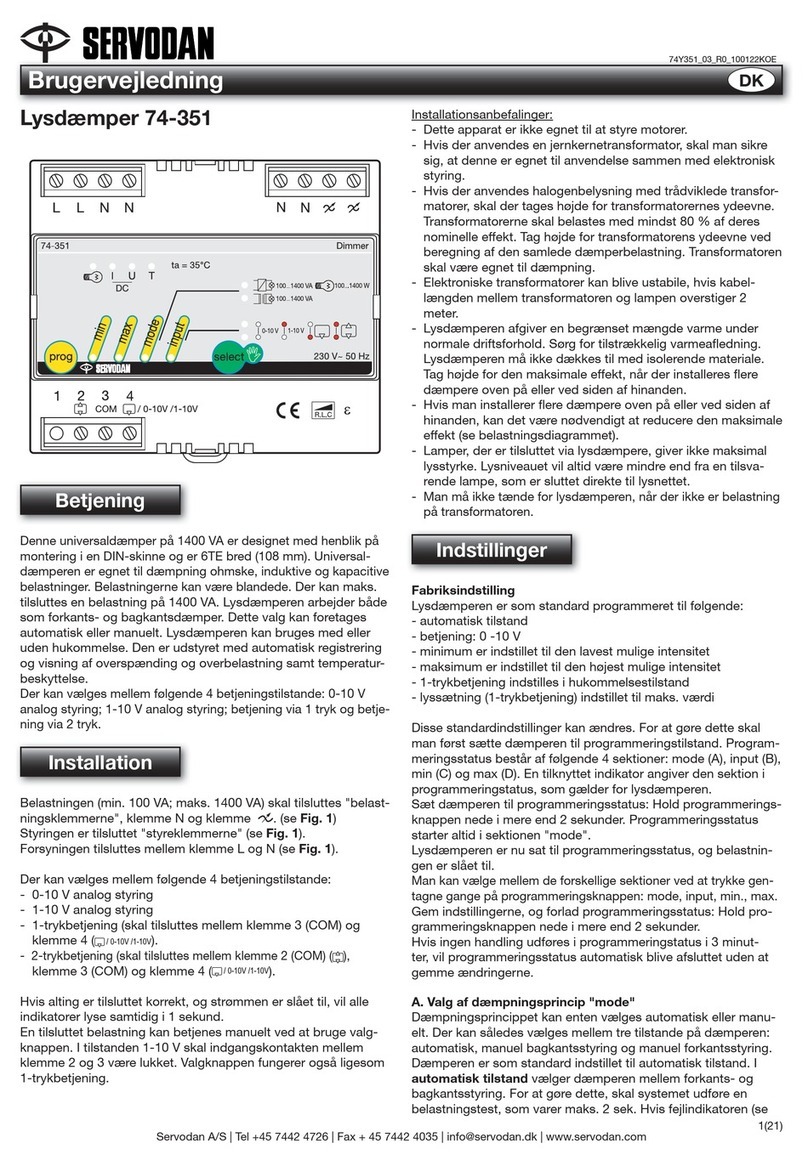
Servodan
Servodan 74-351 user guide

Leviton
Leviton Toggle Touch TGI06-1L installation instructions
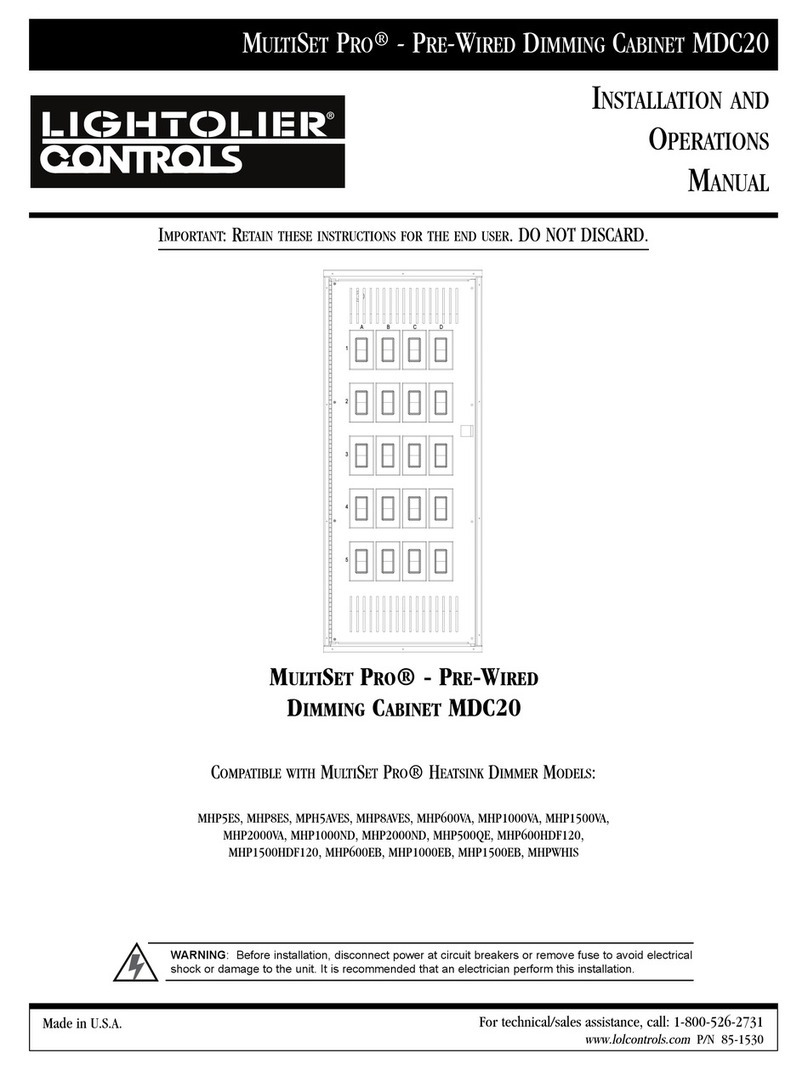
Lightolier
Lightolier MULTISET PRO MDC20 Installation and operation manual
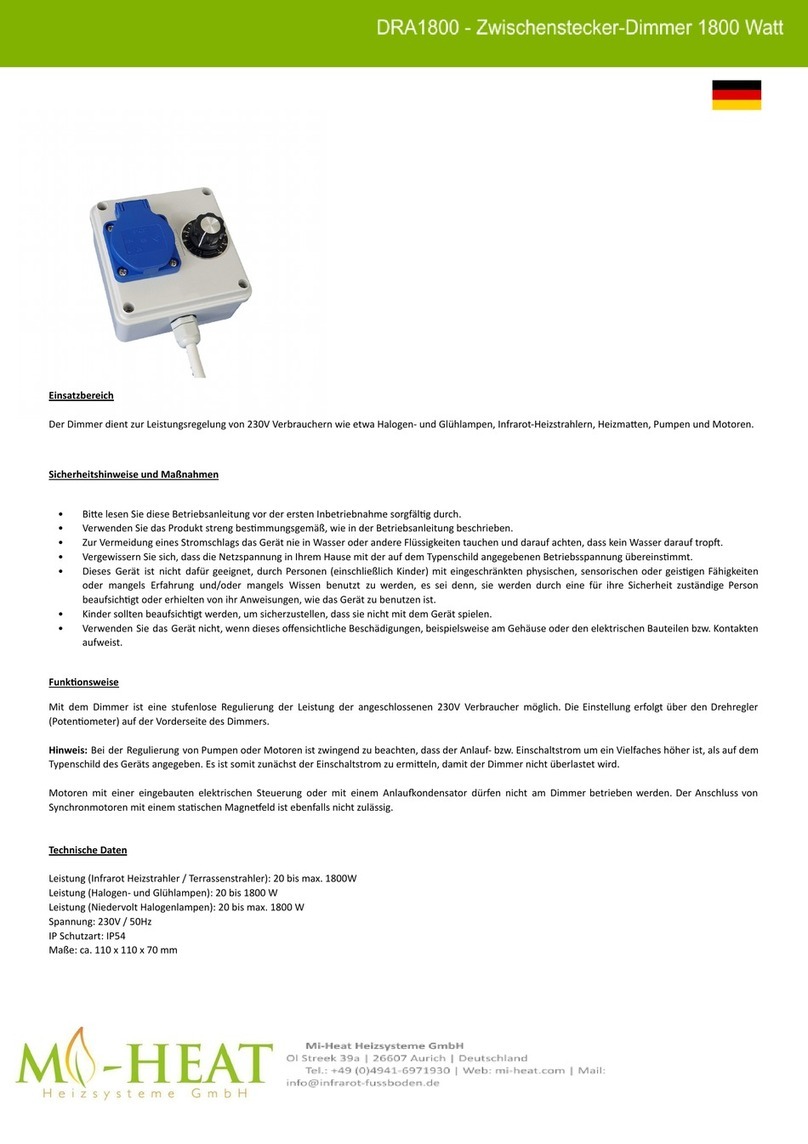
Mi-Heat Heizsysteme
Mi-Heat Heizsysteme DRA1800 quick start guide
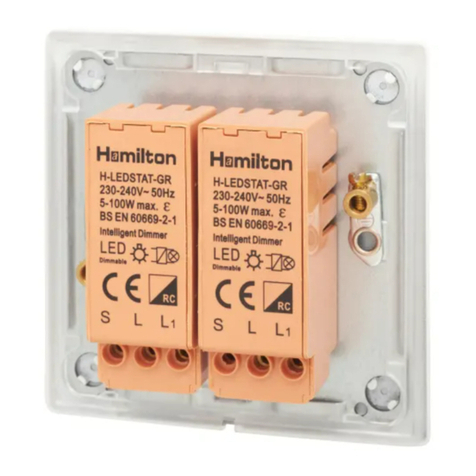
Hamilton
Hamilton H-LED-STAT Installation note

